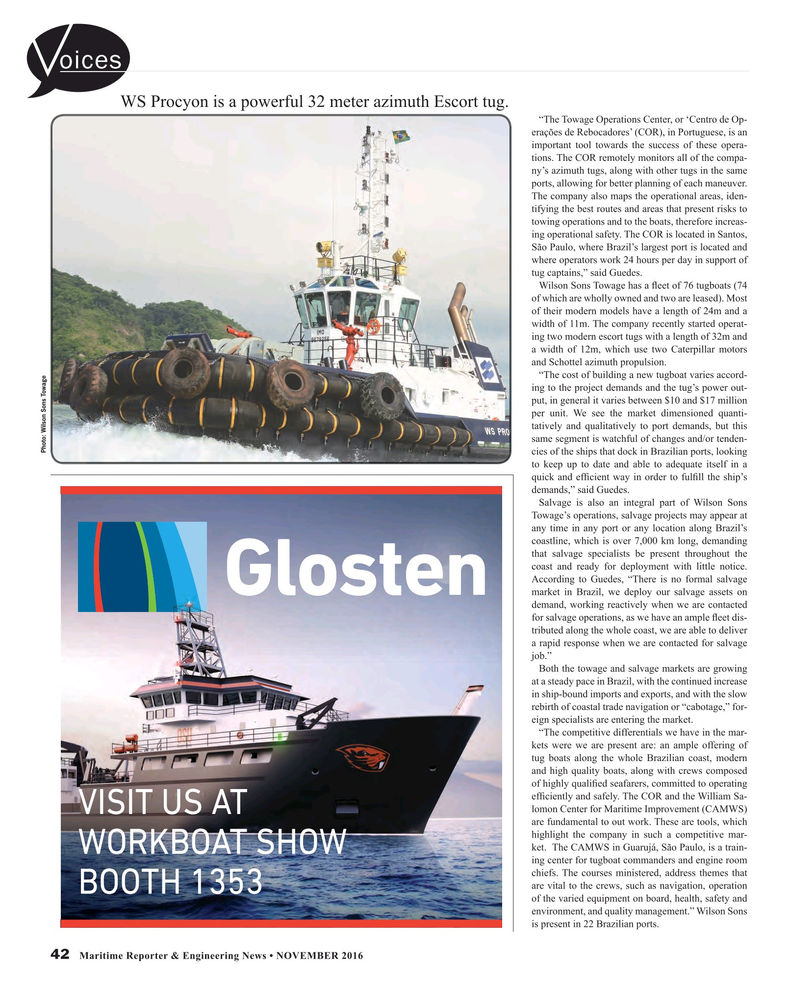
Page 42: of Maritime Reporter Magazine (November 2016)
Workboat Edition
Read this page in Pdf, Flash or Html5 edition of November 2016 Maritime Reporter Magazine
oices
WS Procyon is a powerful 32 meter azimuth Escort tug.
“The Towage Operations Center, or ‘Centro de Op- erações de Rebocadores’ (COR), in Portuguese, is an important tool towards the success of these opera- tions. The COR remotely monitors all of the compa- ny’s azimuth tugs, along with other tugs in the same ports, allowing for better planning of each maneuver.
The company also maps the operational areas, iden- tifying the best routes and areas that present risks to towing operations and to the boats, therefore increas- ing operational safety. The COR is located in Santos,
São Paulo, where Brazil’s largest port is located and where operators work 24 hours per day in support of tug captains,” said Guedes.
Wilson Sons Towage has a ? eet of 76 tugboats (74 of which are wholly owned and two are leased). Most of their modern models have a length of 24m and a width of 11m. The company recently started operat- ing two modern escort tugs with a length of 32m and a width of 12m, which use two Caterpillar motors and Schottel azimuth propulsion. “The cost of building a new tugboat varies accord- ing to the project demands and the tug’s power out- put, in general it varies between $10 and $17 million per unit. We see the market dimensioned quanti- tatively and qualitatively to port demands, but this same segment is watchful of changes and/or tenden-
Photo: Wilson Sons Towage cies of the ships that dock in Brazilian ports, looking to keep up to date and able to adequate itself in a quick and ef? cient way in order to ful? ll the ship’s demands,” said Guedes.
Salvage is also an integral part of Wilson Sons
Towage’s operations, salvage projects may appear at any time in any port or any location along Brazil’s coastline, which is over 7,000 km long, demanding that salvage specialists be present throughout the coast and ready for deployment with little notice.
According to Guedes, “There is no formal salvage market in Brazil, we deploy our salvage assets on demand, working reactively when we are contacted for salvage operations, as we have an ample ? eet dis- tributed along the whole coast, we are able to deliver a rapid response when we are contacted for salvage job.”
Both the towage and salvage markets are growing at a steady pace in Brazil, with the continued increase in ship-bound imports and exports, and with the slow rebirth of coastal trade navigation or “cabotage,” for- eign specialists are entering the market.
“The competitive differentials we have in the mar- kets were we are present are: an ample offering of tug boats along the whole Brazilian coast, modern and high quality boats, along with crews composed of highly quali? ed seafarers, committed to operating ef? ciently and safely. The COR and the William Sa- lomon Center for Maritime Improvement (CAMWS)
VISIT US AT are fundamental to out work. These are tools, which highlight the company in such a competitive mar- ket. The CAMWS in Guarujá, São Paulo, is a train-
WORKBOAT SHOW ing center for tugboat commanders and engine room chiefs. The courses ministered, address themes that are vital to the crews, such as navigation, operation
BOOTH 1353 of the varied equipment on board, health, safety and environment, and quality management.” Wilson Sons is present in 22 Brazilian ports.
42 Maritime Reporter & Engineering News • NOVEMBER 2016
MR #11 (42-49).indd 42 11/3/2016 5:20:54 PM

 41
41

 43
43
